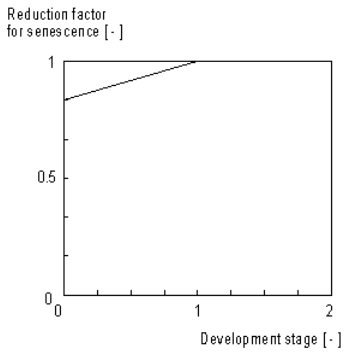Maintenance costs may be estimated based on the quantities of proteins and minerals present in the biomass and on crop metabolic activity, typical values for the maintenance coefficients for various plant organs have been derived by Penning de Vries & van Laar (1982). In WOFOST these coefficients are used to calculate the crop maintenance requirements, which are approximately proportional to the dry weights of the plant organs to be maintained.
Following this logic, the potential maintenance respiration rate (without considering any limitation factor) is expressed by the equation:

where Rman,pot is potential maintenance respiration rate (Kg ha-1 d-1), Rman,roots is maintenance respiration rate of roots (Kg ha-1 d-1), Wroots is dry matter weight of roots (Kg ha-1), Rman,stems is maintenance respiration rate of stems (Kg ha-1 d-1), Wstems is dry matter weight of stems(Kg ha-1), Rman,leaves is maintenance respiration rate of leaves (Kg ha-1 d-1), Wleaves is dry matter weight of leaves(Kg ha-1), Rman,sto is maintenance respiration rate of storage organs (Kg ha-1 d-1), Wsto is dry matter weight of storage organs (Kg ha-1).
Senescence limitation
After this computation, the calculated potential maintenance respiration rate (Rman,pot) has to be corrected for taking into account the senescence limitation. This correction factor is crop specific and is defined as a function of development stage, as shown in the Figure below. An AFGEN table with development stage as independent variable, is used to describe this dependency.

For obtaining the maintenance respiration rate limited by senescence, the following equation is applied:

where Rman,sen is maintenance respiration rate limited by senescence (Kg ha-1 d-1), Rman,pot is potential maintenance respiration rate (Kg ha-1 d-1) and Csen is correction factor due to senescence
Temperature limitation
Higher temperatures accelerate turnover rates in plant tissue and hence costs of maintenance. An increase in temperature of 10°C increases maintenance respiration by a factor of about 2 (Kase & Catsky, 1984).
For considering this effect on the maintenance respiration, a parameter (Q10, to be provided by the user) is introduced, which is defined as the relative increase of the respiration rate per 10°C temperature increase.
Then, the temperature effect can be calculated as:

where Teff is the effect of temperature on the maintenance respiration rate (unitless), Q10 si relative increase of the respiration rate per 10°C temperature increase (unitless) and Tavg is average daily air temperature (°C). 25 stands for the reference temperature in WOFOST.
For obtaining the maintenance respiration rate limited by both temperature and senescence, the following equation is applied:

where Rman,act is actual maintenance respiration rate limited by temperature and senescence (Kg ha-1 d-1), Rman,sen is maintenance respiration rate limited by senescence (Kg ha-1 d-1) and Teff is the effect of temperature on the maintenance respiration rate (unitless).
Then the minimum value between daily gross CH2O assimilation rate (AssCH20, see topic Conversion CO2 to CH2O) and actual maintenance respiration rate Rman,act is taken for defining the real maintenance respiration rate:

where Rman is the real maintenance respiration rate (Kg ha-1, d-1), AssCH20 is daily gross CH2O assimilation rate (kg ha-1 d-1) and Rman,act is actual maintenance respiration rate limited by temperature and senescence (Kg ha-1 d-1).
Created with the Personal Edition of HelpNDoc: Easy to use tool to create HTML Help files and Help web sites